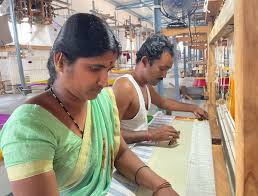The weavers of Narayanpet struggle to preserve handloom and Kalamkari
Although the word “Kalamkari,” which means “craftsmanship,” first came into use in the narration of Hindu mythology, it was also referenced in Buddhist, Jain, and ancient Hindu literature. Because of the Qutb Shahi dynasty’s sponsorship, Kalamkari and the handloom industry that followed it flourished in the area. Cut to the present day, when the ever-industrializing textile industry has had a negative impact on the colored block-painting of cloth. Narayanpet’s weavers and artists, however, are fighting against capitalism and working to maintain the handloom business and craft in addition to safeguarding the region’s cultural legacy.

The Government of India granted the Machilipatnam Kalamkari in undivided Andhra Pradesh the Geographical Indication (GI) in 2008, which is still more than ten years ago. Although this art style is well-known throughout the Krishna region of Andhra Pradesh, Narayanpet’s Kalamkari sarees are renowned for their exquisite craftsmanship and distinctive border motifs, which are created via a protracted and difficult procedure.
While handloom sarees need weaving, warping, and dying, a Kalamkari item further requires hand painting the motifs and dying the borders in red and black, among other laborious steps.
Many local weavers lost their jobs as a result of the Covid-19-induced lockdown, which had a negative impact on the industry and forced them to give up their art in order to live. Nonetheless, a few of them made the decision to resume their handloom labor due to their passion and love for the craft.
Many local artists, particularly women, who have been working in the field for a long time and are also leaving a legacy for future generations, have found work in the handloom sector.
Something to be admired
Working on the heavy wooden handloom is nearly second nature to Kasturi, 78, who has been a weaver since childhood. She has been employed in the handloom industry for more than five years. “Being raised by weavers, I was exposed to weaving from an early age. Since I was the only provider for my family after my wedding, I started doing handloom labor as a source of income. It was after that I came to admire it. I now have a greater responsibility to preserve the rich legacy of weaving, and I hope that this can help in some little way,” she tells TNIE.
Depending on the pattern, each weaver receives between Rs 2,000 and Rs 6,000 for a saree, but their monthly income of around Rs 15,000 is insufficient for them to support a family.
Hemlatha, a 45-year-old weaver who has been in the industry for ten years, discusses the difficulties the community faces in light of the growing demand for ready-made clothing and the lack of appreciation and knowledge for handlooms.
“Due to inadequate compensation for the arduous and tiresome work, it is becoming increasingly difficult to continue with this work.” I face a different set of difficulties every day as I take care of my family and kids before heading to work. We can weave a sizable quantity of sarees in a month if the weather is cooperative, but inclement weather causes labor to slow down, which also has an impact on our pay, Hemlatha continues.
P Prasad, a Kalamkari craftsman who comes from a family of weavers, claims his father taught him the trade. He continues, “Even though he worked as a weaver from a young age, he switched to Kalamkari because it pays higher wages.”
He says, “A Kalamkari saree is very difficult to make.” “Creating colors and dying the cloth is a time-consuming and exacting procedure. Compared to synthetic dyes, working with natural colors requires more labor and time. In addition to making a respectable living, I hope that the industry and society will value our artwork, recognize the work we do to preserve the original craft, and see us as important contributors to the craft sector. We often experience neglect, which might be discouraging, but what keeps us going is our sincere passion for the art.
Depending on the pattern, Kalamkari artisans might make anywhere from Rs 4,000 to Rs 15,000 for a single saree.
Working with the weavers and craftsmen of Narayanpet, Konda Kavitha Reddy is a designer, textile revivalist, and the creator of Kavidhara Handlooms. She has over 20 years of experience in the handloom business. She emphasizes that it is imperative to revive the industry, which is on the verge of extinction.
What kind of legacy are we leaving for our future generations, Kavitha asks TNIE in an interview. For their sake, it is imperative that we bring back our fabrics, patterns, weaving methods, and distinctive, traditional art forms. Our main concern at the moment is keeping regionally distinct designs unique, since they are becoming less genuine due to outside influences diluting them. Regretfully, this also applies to handloom sarees from Narayanpet.






